Keep your phone's camera lens spotless with these quick tips. Use a microfiber cloth for daily cleaning, gently wiping in circular motions. For tougher grime, dampen the cloth with a specialized lens solution. Avoid harsh chemicals and excessive pressure. Compressed air can effectively remove dust without touching the lens. When dealing with water droplets, dab gently with a dry microfiber cloth. Clean multiple lenses individually, focusing on edges where dirt accumulates. Store your phone in a protective case or lens pouch to prevent scratches. Implement a regular cleaning routine for consistently clear photos. These simple techniques are just the beginning of maintaining pristine camera lenses.
Microfiber Cloth: Your Best Friend
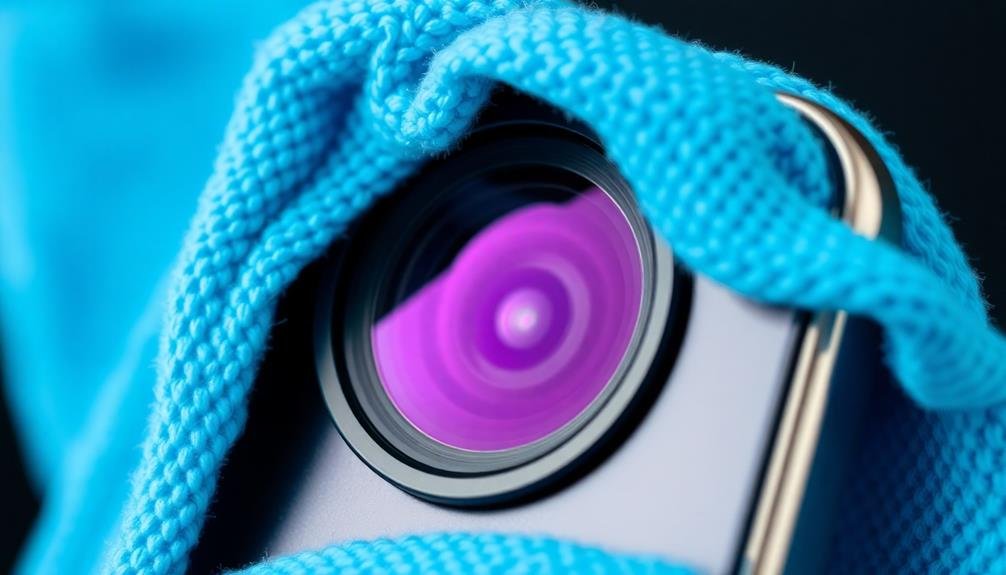
One essential tool for keeping your phone camera lens spotless is a microfiber cloth. This soft, lint-free fabric is designed to gently remove smudges, fingerprints, and dust without scratching your delicate lens.
Always keep a small microfiber cloth in your pocket or bag for quick cleanings on the go.
To use the cloth effectively, start by gently blowing on the lens to remove any loose particles. Then, using light circular motions, wipe the lens with the microfiber cloth. Don't press too hard; let the fabric's fibers do the work.
If you encounter stubborn smudges, slightly dampen a corner of the cloth with distilled water or lens cleaner.
Remember to clean your microfiber cloth regularly to maintain its effectiveness. Hand wash it with mild soap and warm water, then air dry.
Avoid using fabric softeners or bleach, as these can leave residues that may transfer to your lens. Replace your cloth when it becomes worn or loses its cleaning power.
For best results, pair your microfiber cloth with a small air blower to remove dust before wiping. This two-step process guarantees a thorough cleaning without risking scratches from trapped particles.
Lens Cleaning Solution Basics
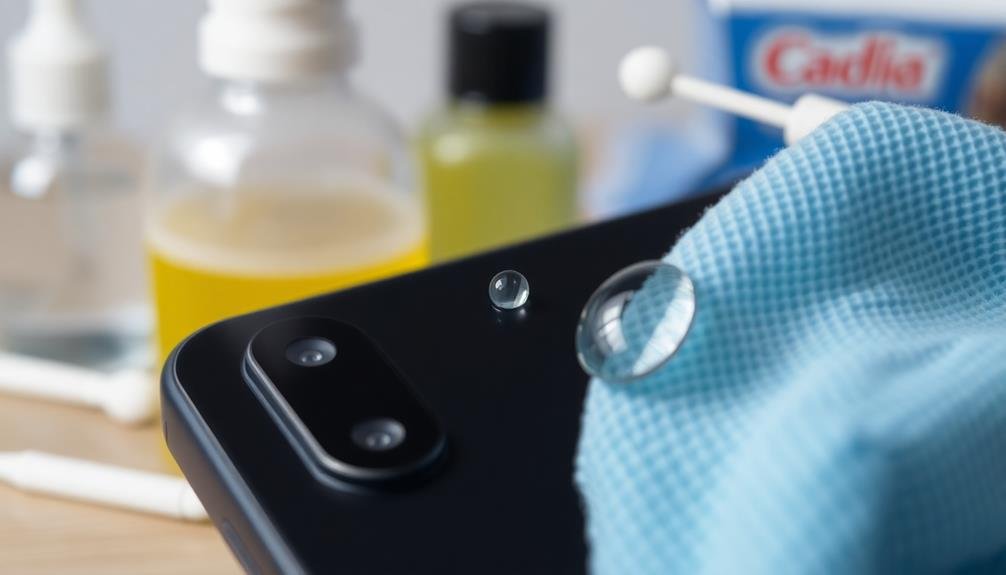
Cleanliness enthusiasts know that a microfiber cloth alone isn't always enough to tackle stubborn smudges on your phone's camera lens. That's where lens cleaning solutions come in handy. These specialized liquids are designed to dissolve oils, dirt, and grime without damaging your device's delicate optics.
When choosing a lens cleaning solution, opt for one specifically formulated for electronic devices. Avoid harsh chemicals like alcohol or ammonia, which can strip protective coatings from your lens. Instead, look for gentle, pH-neutral formulas that won't leave residues.
To use a lens cleaning solution effectively, apply a small amount to a microfiber cloth—never directly to the lens. Gently wipe the lens in circular motions, starting from the center and moving outward. Don't apply excessive pressure, as this can damage the lens or push debris into crevices.
For best results, use the solution sparingly. Overuse can lead to buildup or streaking. After cleaning, let the lens air dry for a few seconds before using your camera.
If you're in a pinch, you can make a DIY solution using distilled water and a drop of mild dish soap, but commercial products are generally safer and more reliable.
Avoid Harsh Chemicals
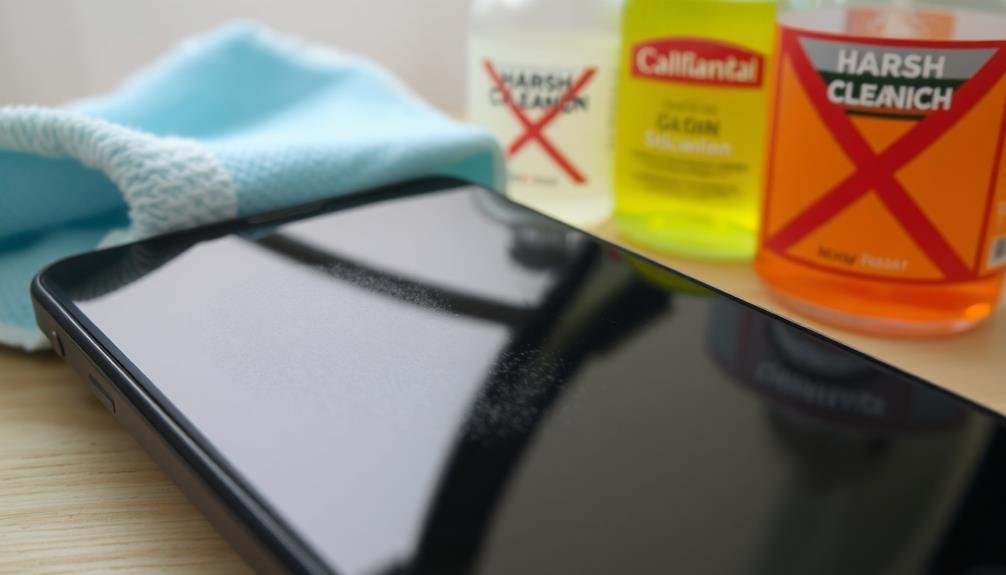
When cleaning your phone's camera lens, it's vital to steer clear of harsh chemicals that can damage the protective coating.
You'll want to avoid substances that could potentially corrode the lens surface or surrounding components, as this can lead to permanent damage.
Protect Lens Coating
The delicate coating on your phone's camera lens is its first line of defense against scratches and glare. To maintain this protective layer, you'll need to be cautious with your cleaning methods.
Avoid using any abrasive materials, such as rough cloths or paper towels, which can gradually wear down the coating. Instead, opt for a soft microfiber cloth specifically designed for cleaning lenses.
When cleaning, use gentle circular motions and avoid applying excessive pressure. If you need to remove stubborn smudges, slightly dampen the cloth with distilled water or a specialized lens cleaning solution.
Never use household cleaners, solvents, or alcohol-based products, as these can strip away the protective coating.
To further safeguard your lens coating, consider using a protective case with a raised edge around the camera. This will help prevent the lens from coming into direct contact with surfaces when you set your phone down.
Additionally, always store your phone in a clean, dust-free environment when not in use. By taking these precautions, you'll help preserve the lens coating and guarantee your phone's camera continues to capture crystal-clear images for years to come.
Prevent Corrosion Damage
Corrosion's insidious effects can permanently damage your phone's camera lens, compromising image quality and functionality. To prevent this, you'll need to be vigilant about what comes into contact with your lens.
Avoid using harsh chemicals like ammonia, alcohol, or bleach-based cleaners, as these can erode the protective coating and corrode the lens material.
Instead, opt for gentle cleaning methods. Use a microfiber cloth slightly dampened with distilled water to wipe away dirt and smudges. For stubborn grime, create a solution of mild dish soap and water, but use it sparingly. Always dry the lens thoroughly after cleaning to prevent moisture buildup.
Be cautious of environmental factors that can accelerate corrosion. Salt water, high humidity, and air pollution can all contribute to lens degradation. If you're in these conditions, clean your lens more frequently and consider using a protective case.
Don't forget about your phone case, either. Some materials can trap moisture or release corrosive substances. Choose a case that allows proper ventilation around the camera area and doesn't use materials that might react with your lens coating.
Maintain Optical Clarity
How can you keep your phone's camera lens crystal clear without resorting to harsh chemicals? The key is to use gentle, non-abrasive materials and techniques that won't damage the delicate lens coating.
Opt for microfiber cloths specifically designed for cleaning lenses, as they're soft and won't leave scratches or residue. When wiping, use circular motions to effectively remove smudges and fingerprints.
For stubborn dirt or grime, slightly dampen the cloth with distilled water. Avoid tap water, as it can contain minerals that may leave deposits on the lens. If water alone isn't sufficient, create a mild cleaning solution by mixing equal parts distilled water and white vinegar. Apply this mixture sparingly to the cloth, not directly to the lens.
To maintain optical clarity and protect your phone's camera lens, follow these additional tips:
- Use a lens cap or protective case when not in use
- Clean your lens regularly to prevent buildup of dirt and oils
- Avoid touching the lens with your fingers to reduce smudges
Gentle Circular Motions
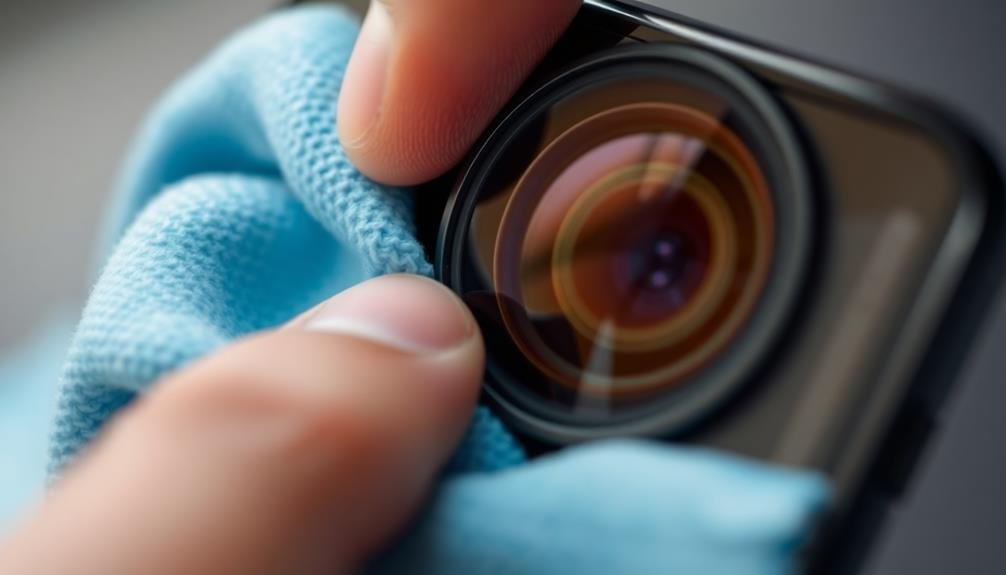
When it comes to cleaning your phone's camera lens, gentle circular motions are key. You'll want to use a soft, lint-free microfiber cloth to avoid scratching the delicate lens surface. Start at the center of the lens and work your way outward in small, gentle circles. Don't apply too much pressure; let the cloth do the work.
For stubborn smudges, you can slightly dampen the cloth with distilled water or a lens cleaning solution. Be careful not to use too much liquid, as it could seep into the phone's internals. After cleaning, use a dry part of the cloth to remove any remaining moisture.
Here's a quick guide to effective lens cleaning:
| Do | Don't |
|---|---|
| Use microfiber cloth | Use abrasive materials |
| Apply gentle pressure | Scrub aggressively |
| Clean in circular motions | Use excessive liquid |
| Start from center, move outward | Touch lens with bare fingers |
Compressed Air for Dust Removal

Compressed air can be a powerful ally in your phone camera lens cleaning arsenal. It's an effective method for removing dust and small particles that can accumulate on your lens over time.
When using compressed air, hold the can upright and about 6 inches away from the lens. Use short, controlled bursts rather than a continuous stream to avoid damaging the lens or forcing moisture into the phone's internal components.
Before using compressed air, verify you're in a well-ventilated area and that your phone is turned off. This precaution helps prevent any potential damage from static electricity.
After using compressed air, inspect the lens closely to see if any stubborn particles remain. If so, you may need to use other cleaning methods in conjunction with the compressed air.
Here are three key benefits of using compressed air for lens cleaning:
- It's a non-contact method, reducing the risk of scratching the lens
- It can reach tight spaces and corners that microfiber cloths can't
- It's quick and easy to use, making it ideal for on-the-go cleaning
Q-Tips for Hard-to-Reach Areas

The humble Q-tip, often overlooked in phone cleaning kits, can be a secret weapon for tackling hard-to-reach areas of your camera lens. Its small, soft tip allows you to gently clean corners and edges that other tools can't reach. When using Q-tips, opt for those with 100% cotton tips to avoid scratching your lens.
To effectively use Q-tips for lens cleaning, follow these steps: First, lightly dampen the tip with a cleaning solution. Next, gently swab the lens in a circular motion, paying extra attention to the edges. Finally, use a dry Q-tip to remove any remaining moisture.
Here's a quick reference guide for Q-tip cleaning techniques:
| Area | Technique | Tip |
|---|---|---|
| Lens Edges | Circular Motion | Use light pressure |
| Corners | Gentle Dabbing | Change tips frequently |
| Lens Surface | Sweeping Motion | Avoid excess moisture |
Remember to dispose of used Q-tips after each cleaning session to prevent cross-contamination. While Q-tips are effective, they shouldn't replace regular cleaning methods. Instead, use them as a complementary tool to maintain your phone's camera lens in pristine condition.
Screen Protectors for Lenses

Protecting your phone's camera lens is just as important as keeping it clean. Screen protectors designed specifically for camera lenses offer an extra layer of defense against scratches, dust, and minor impacts.
These thin, transparent films adhere directly to your phone's camera lens, preserving its clarity while safeguarding it from daily wear and tear.
When choosing a screen protector for your camera lens, look for options made from high-quality materials like tempered glass or specialized plastics. These materials guarantee peak light transmission, maintaining your camera's image quality.
Installation is typically straightforward, but it's vital to follow the instructions carefully to avoid trapping air bubbles or dust particles beneath the protector.
Here are three key benefits of using screen protectors for your phone's camera lens:
- Scratch resistance: Prevents micro-scratches from keys, coins, or other objects in your pocket or bag
- Easier cleaning: The smooth surface of the protector makes wiping away smudges and fingerprints simpler
- Resale value: Keeps your phone's camera lens in pristine condition, potentially increasing its resale value
Remember to replace the screen protector if it becomes damaged or worn to maintain peak protection for your phone's camera lens.
Regular Maintenance Schedule
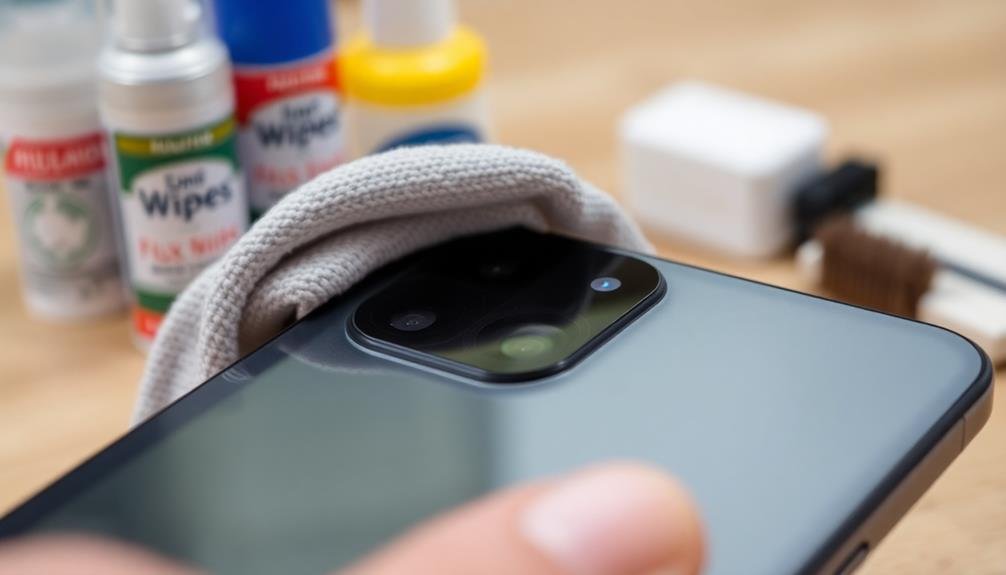
How often should you clean your phone's camera lens? Ideally, you'll want to incorporate lens cleaning into your daily routine. A quick wipe with a microfiber cloth each morning can prevent the buildup of oils, dust, and fingerprints that accumulate throughout the day.
For a more thorough cleaning, set a weekly schedule. Choose a specific day, like every Sunday evening, to give your phone's camera lens a deeper clean. Use a lens cleaning solution and a fresh microfiber cloth to gently remove any stubborn smudges or residue.
Don't forget about monthly maintenance. Once a month, inspect your lens for any scratches or damage. If you use a lens protector, this is a good time to replace it if necessary.
Lastly, consider seasonal care. As the weather changes, so do the environmental factors affecting your phone.
In spring and fall, be extra vigilant about pollen and dust. During summer, watch out for sunscreen residue, while winter months might require more frequent cleaning due to moisture from snow or rain.
Lens Cleaning Wipes On-The-Go
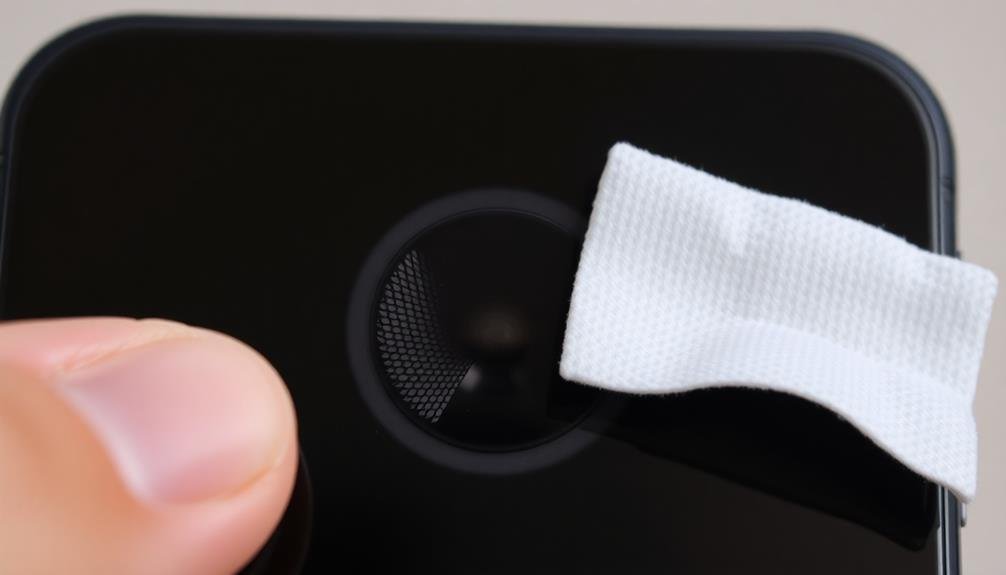
You'll find lens cleaning wipes incredibly convenient for maintaining your phone's camera while on the move.
These portable wipes often come individually wrapped, making them easy to slip into your pocket or bag.
The gentle cleaning solution in these wipes is typically formulated with ingredients that effectively remove smudges and fingerprints without damaging your lens's delicate coating.
Convenience of Portable Wipes
Lens cleaning wipes offer unparalleled convenience for smartphone photographers on the move. These portable, single-use wipes are designed to fit easily into your pocket, wallet, or camera bag, guaranteeing you're always prepared to clean your phone's camera lens.
They're pre-moistened with a gentle cleaning solution that effectively removes fingerprints, smudges, and dust without leaving streaks or residue.
You'll appreciate the convenience of portable wipes for several reasons:
- Quick and easy to use – just tear open the package and wipe your lens
- No need to carry bulky cleaning solutions or microfiber cloths
- Disposable after use, eliminating the need to clean or maintain cleaning tools
When selecting lens cleaning wipes, opt for those specifically formulated for electronic devices and camera lenses.
These wipes are safe for delicate optical surfaces and won't damage your phone's lens coating.
Keep a few packets in your car, office desk, and travel bag to guarantee you're always ready to capture crystal-clear images.
With portable lens cleaning wipes at your disposal, you'll never miss a perfect shot due to a dirty lens again.
Gentle Cleaning Solution Ingredients
While portable lens cleaning wipes offer convenience, it's important to understand the ingredients in their gentle cleaning solutions. Most high-quality lens cleaning wipes contain a mixture of isopropyl alcohol, purified water, and sometimes a small amount of mild detergent. Isopropyl alcohol is effective at breaking down oils and fingerprints without leaving residue, while water helps dilute the solution and prevent streaking.
You'll want to avoid wipes with harsh chemicals or abrasive materials that could damage your phone's lens coating. Look for wipes specifically designed for electronic devices and camera lenses. Some brands include anti-static agents to repel dust and prevent future smudges.
If you're concerned about synthetic ingredients, there are eco-friendly options available. These may use plant-based alcohols or natural surfactants derived from coconut oil. However, verify these natural alternatives are still effective at cleaning without leaving behind any residue.
When choosing lens cleaning wipes, always check the ingredients list and opt for those with minimal, gentle components. This will help you maintain your phone's camera lens without risking damage to its delicate surface or compromising image quality.
Avoiding Fingerprints and Smudges

Keeping your phone's camera lens free from fingerprints and smudges can make a world of difference in your photo quality. To maintain a pristine lens, you'll need to develop some habits that prevent these marks from appearing in the first place.
When handling your phone, be mindful of where you're placing your fingers. Try to avoid touching the camera area altogether, and if you must, use the edges of your device instead.
Consider investing in a protective case with a raised edge around the camera lens. This design helps prevent accidental contact with the lens when you set your phone down on flat surfaces.
Additionally, always store your phone in a clean, lint-free pocket or bag to minimize exposure to dust and debris.
Here are three quick tips to help you avoid fingerprints and smudges:
- Use a microfiber cloth to wipe your lens before and after each use
- Apply a small, clear protective film over the camera lens
- Train yourself to hold your phone by its sides, keeping fingers away from the back
Cleaning Multiple Lenses Effectively

Modern smartphones often feature multi-lens camera systems, each requiring individual attention for ideal performance. To clean multiple lenses effectively, start by using a microfiber cloth to gently wipe each lens in a circular motion. This removes surface dust and light smudges without risking scratches.
For stubborn dirt, lightly dampen a corner of the cloth with distilled water or a specialized lens cleaning solution. Be careful not to oversaturate, as excess liquid can seep into the phone's internals. Gently clean each lens individually, guaranteeing you don't cross-contaminate between lenses.
Pay special attention to the edges where the lens meets the phone's body, as dirt often accumulates in these areas. Use a dry corner of the cloth to remove any remaining moisture immediately after cleaning.
For hard-to-reach spots, consider using a soft-bristled brush or compressed air to dislodge debris. Always blow air at an angle to prevent pushing particles into the lens assembly.
Remember to clean the flash and any additional sensors near the camera lenses, as these can affect photo quality. Regularly maintaining all components of your phone's camera system will guarantee consistently clear and sharp images.
Dealing With Water Droplets
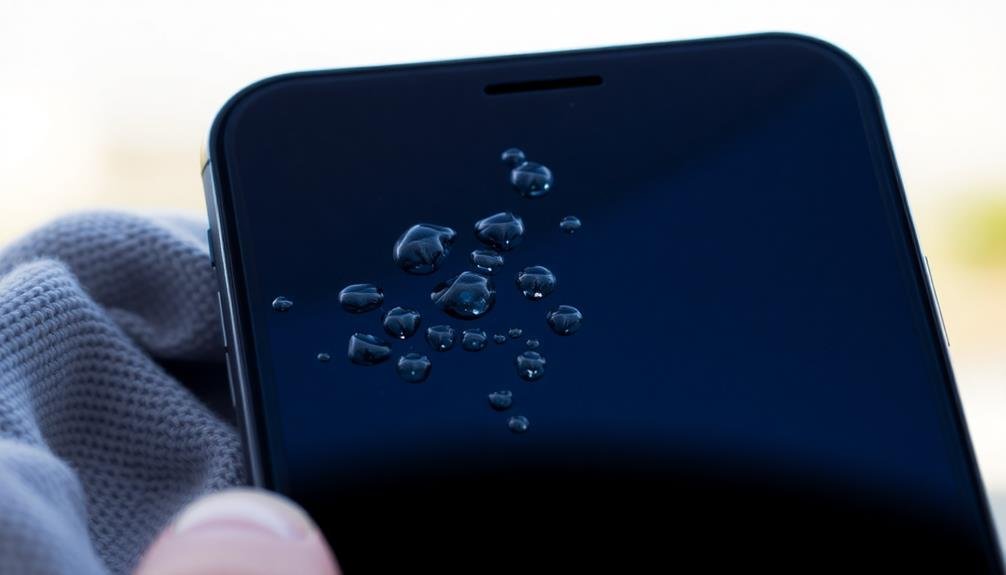
When your phone camera lens is covered in water droplets, you've got a few effective methods to clear them away.
You can gently dab the lens with a microfiber cloth, using a circular motion to absorb the moisture.
If you prefer a hands-off approach, try blasting the lens with compressed air, or apply a specialized lens cleaning solution to break down the droplets and wipe them away easily.
Microfiber Cloth Drying Technique
A microfiber cloth is your secret weapon for dealing with water droplets on your phone's camera lens. This soft, lint-free material effectively absorbs moisture without scratching the delicate lens surface.
To use it properly, gently dab the cloth on the lens rather than wiping, which can spread the water and potentially leave streaks. Verify your microfiber cloth is clean and dry before use, as a dirty cloth can transfer particles onto the lens.
For best results, follow these steps:
- Hold your phone with the camera lens facing downward to prevent additional water from running onto the cleaned area.
- Use short, light tapping motions with the microfiber cloth to absorb the water droplets.
- Inspect the lens under good lighting to verify all droplets have been removed.
If you're in a pinch without a microfiber cloth, avoid using tissues, paper towels, or your clothing, as these can scratch the lens or leave fibers behind.
Instead, let the lens air dry if possible, or use a soft, clean cotton cloth as a last resort. Remember to always carry a small microfiber cloth in your phone case or wallet for quick lens cleaning on the go.
Compressed Air Blast Method
Blast away water droplets from your phone's camera lens using compressed air. This method is particularly effective when you're dealing with stubborn moisture that won't budge with a microfiber cloth. You'll need a can of compressed air, which you can easily find at electronics or office supply stores.
Hold your phone at a slight angle, with the camera lens facing downward. This positioning allows gravity to assist in removing the water droplets. Keep the compressed air can about 6 inches away from the lens to avoid damaging it. Give short, controlled bursts of air rather than a continuous stream. This technique helps prevent the propellant from leaving residue on your lens.
As you spray, you'll see the water droplets scatter and evaporate quickly. Pay special attention to the edges of the lens where water might accumulate. If any droplets remain, repeat the process.
Once you've finished, inspect the lens carefully to confirm it's completely dry. Remember to cap the compressed air can after use and store it upright to maintain its effectiveness for future cleaning sessions.
Lens Cleaning Solution Application
Applying a specialized lens cleaning solution offers another effective method for dealing with water droplets on your phone's camera lens. This technique can remove stubborn smudges and residue that compressed air alone mightn't eliminate.
When using a lens cleaning solution, it's essential to choose one specifically designed for camera lenses to avoid damaging the delicate coating.
To apply the solution effectively, follow these steps:
- Apply a small amount of the cleaning solution to a microfiber cloth, not directly on the lens.
- Gently wipe the lens in a circular motion, starting from the center and moving outward.
- Use a dry part of the cloth to remove any excess moisture and polish the lens.
Be cautious not to use too much solution, as excess liquid can seep into the phone's internal components.
After cleaning, allow the lens to air dry completely before taking photos. If you're in a hurry, you can use a gentle stream of compressed air to speed up the drying process.
Remember to clean your phone's camera lens regularly to maintain ideal image quality and prevent buildup of dirt and oils.
Tackling Stubborn Dirt and Grime

Sometimes, regular cleaning methods just won't cut it when it comes to stubborn dirt and grime on your phone's camera lens. For these tough cases, you'll need to step up your cleaning game. Start by using a soft-bristled brush to gently dislodge any loose particles. If that doesn't work, try using a slightly dampened microfiber cloth with distilled water to avoid leaving mineral deposits.
For particularly stubborn spots, you might need to use specialized cleaning solutions. Here's a comparison of different methods and their effectiveness:
| Cleaning Method | Effectiveness | Potential Risks |
|---|---|---|
| Isopropyl Alcohol | High | May damage coatings |
| Lens Pen | Medium | Limited to dry dirt |
| Compressed Air | Medium | Can push dirt deeper |
| Ultrasonic Cleaner | Very High | Expensive equipment |
| Hydrogen Peroxide | High | May bleach surfaces |
Proper Storage to Prevent Scratches

To keep your phone camera lens scratch-free, you'll want to focus on proper storage techniques.
Invest in a high-quality protective case that covers the entire phone, including the camera area.
For added protection, consider using dedicated lens pouches when your phone isn't in use, especially if you're carrying it in a bag with other items.
Use Protective Cases
Protecting your phone's camera lens starts with a good case. A well-designed case not only shields your device from drops and impacts but also keeps the camera lens safe from scratches and debris.
When choosing a case, look for one that has a raised edge around the camera area, providing an extra layer of protection when you set your phone down.
Evaluate cases with built-in lens covers or flaps that you can easily open when you're ready to take a photo. These features offer maximum protection when you're not using the camera. If you prefer a slimmer profile, opt for cases with reinforced corners and a slightly recessed camera area.
Here are three key factors to weigh when selecting a protective case:
- Material durability (e.g., shock-absorbing TPU or polycarbonate)
- Camera lens protection features (raised edges, covers, or flaps)
- Overall design compatibility with your phone model
Remember that even with a protective case, you should still handle your phone with care. Avoid placing it in pockets or bags with keys, coins, or other hard objects that could potentially scratch the lens.
Dedicated Lens Pouches
Dedicated lens pouches offer an extra layer of protection for your phone's camera lens when you're not using a case or need additional safeguarding.
These small, soft pouches are designed specifically to cradle your phone's camera lens, shielding it from scratches, dust, and debris.
When you're not using your phone, slip it into a dedicated lens pouch before placing it in your pocket or bag. This simple habit can greatly reduce the risk of accidental scratches or smudges on your camera lens.
Look for pouches made from microfiber materials, which not only protect but also gently clean the lens surface as you insert and remove your phone.
Some lens pouches come with drawstrings or closures to guarantee a snug fit and prevent your phone from slipping out.
Others feature reinforced corners for added protection against impacts.
You can find pouches in various sizes to accommodate different phone models and camera configurations.
For photographers who use clip-on lenses or other accessories, dedicated pouches can also protect these add-ons when not in use.
Frequently Asked Questions
Can I Use My Breath to Fog up the Lens Before Cleaning?
You shouldn't use your breath to fog up the lens before cleaning. It can introduce moisture and potentially harmful bacteria. Instead, use a microfiber cloth or lens cleaning solution for safe and effective cleaning of your phone's camera lens.
How Often Should I Replace My Microfiber Cloth for Optimal Cleaning?
You should replace your microfiber cloth every 3-6 months, depending on usage. If it's visibly dirty or doesn't clean effectively, it's time for a new one. Don't wait too long, as old cloths can scratch your lens.
Is It Safe to Use Alcohol Wipes on Phone Camera Lenses?
You shouldn't use alcohol wipes on phone camera lenses. They can damage the lens coating. Instead, use a microfiber cloth slightly dampened with distilled water. It's gentler and just as effective for cleaning your phone's camera lens.
Can Extreme Temperatures Affect the Effectiveness of Lens Cleaning Solutions?
Yes, extreme temperatures can impact your lens cleaning solutions. You'll find that cold weather thickens them, while heat may cause evaporation. It's best to store and use your cleaners at room temperature for maximum effectiveness.
Should I Clean My Phone Case Along With the Camera Lenses?
Yes, you should clean your phone case along with the camera lenses. It'll help prevent dirt and debris from transferring back to the lenses. Use a soft cloth and mild cleaning solution for both to maintain overall cleanliness.
In Summary
You've now got the tools to keep your phone's camera lenses crystal clear. Remember, gentle care is key. Use your microfiber cloth regularly, apply cleaning solutions sparingly, and always use circular motions. Don't forget about those multiple lenses! With proper storage and occasional deep cleaning, you'll guarantee your phone captures life's moments in stunning clarity. Keep these tips in mind, and you'll never miss a shot due to a smudged lens again.

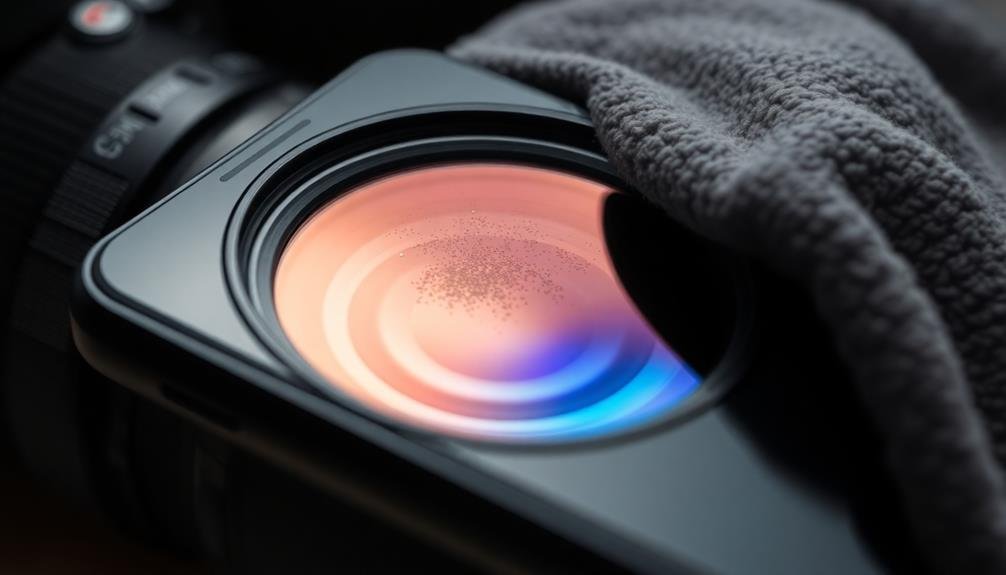



Leave a Reply